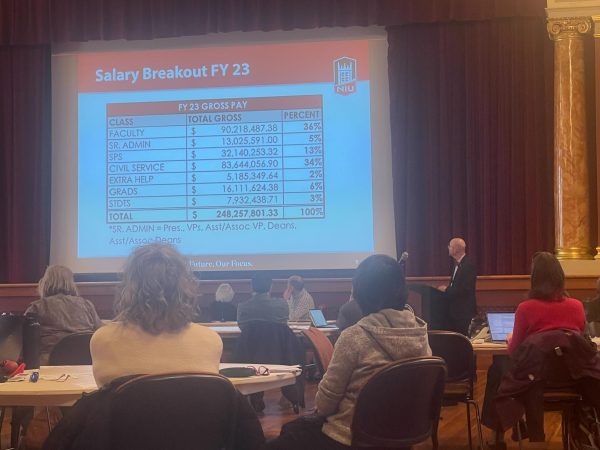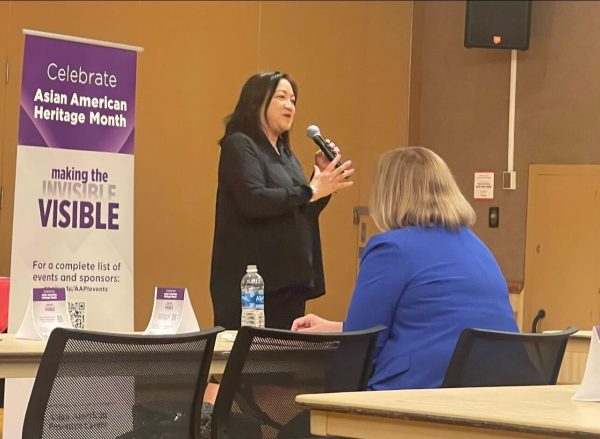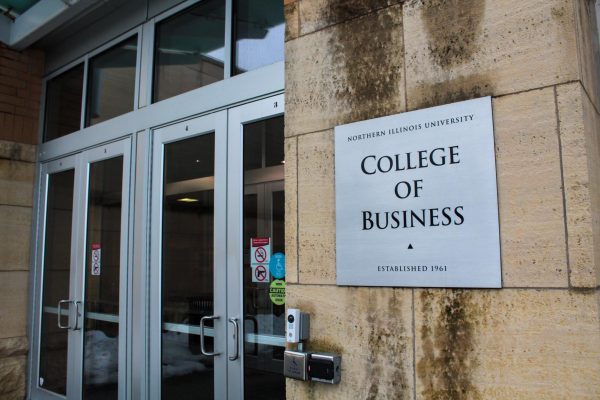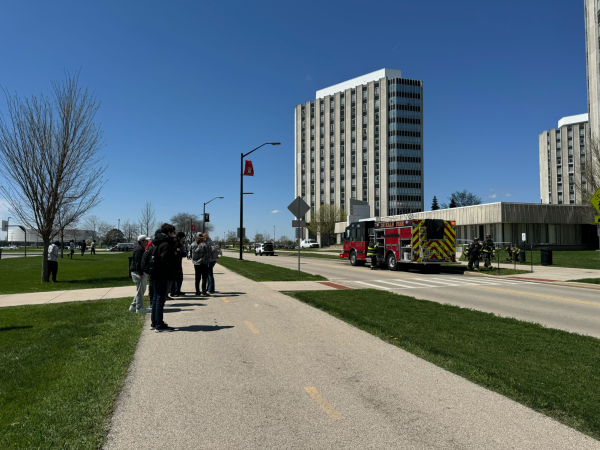Program prioritization: All programs to face NIU’s reviews
Anthropology professor Mitch Irwin (left) and biology professor Karen Samonds perform a health check on a lemur during a July research project in Madagascar. They lead summer a NIU study abroad program on the island. “Hands-on experience in the field is critical as a complement to traditional instruction for ensuring student career success,” Irwin said.NIU President Doug Baker and Provost Lisa Freeman will explain program prioritization and how it will affect university programs like those pictured and employees at town hall meetings today.
January 29, 2015
Provost Lisa Freeman said there will be “no sacred cows” as NIU evaluates whether programs will be cut, merged, further funded or left unchanged in coming months.
Every program, from football to forensics, will face evaluation based on university priorities, Freeman said. NIU President Doug Baker and Freeman will use town hall meetings today to explain the goals of this process and how it will be conducted.
The program prioritization process will revolve around bringing programs in line with NIU’s mission and vision while honoring employees’ contracts and guaranteeing students can finish their academic programs, Freeman said.
“… This effort is to look at all of our programs … and see are there places where we need to invest or are there places where we can shift resources to other things,” Baker said. “This is just a prioritization process to look at all that and see if our budget is in alignment with the work that we need to do to fulfill our mission.”
The process, which began with an exploration period in the fall, is set to last until spring 2016, when funding will be allocated for Fiscal Year 2017 based on program prioritization recommendations.
What prioritization is
Baker said NIU started using prioritization when it came to hiring last year: The university spends about 70 percent of its budget on salaries, so a team went through vacant positions to determine what spots needed to be filled based on need and budget principles. Leaving low-priority positions empty helped NIU make up a structural deficit, he said.
This year, NIU wanted to use a more systemic prioritization process, Baker said. All programs — which are defined as “any activity or collection of activities that consume resources” in today’s town hall presentation — will be reviewed by an academic or administrative task force.
The criteria programs will be reviewed with has not been chosen, but input from the campus community will be used to determine them.
The program prioritization process will help NIU save money by creating efficiencies when programs merge, showing NIU growing programs that will benefit from more resources and helping NIU find targets that can be used for fundraising, Freeman said.
Some programs may be merged, shuttered, diminished in size or granted more resources after the prioritization process.
In the future, a program prioritization process will take place once every three to four years and last 12 months, Freeman said.
Process
Following today’s town halls, NIU will launch a website with information about program prioritization. A survey to be released in February and “broad campus participation” will be used to develop program review criteria, according to today’s town hall presentation.
Faculty and staff will be able to take the survey.
Later in the spring, nominations will be accepted for the academic program task force and the administrative program task force. The academic task force will include tenured faculty representatives from all seven colleges, while the administrative task force will have representatives from NIU’s 10 divisions.
Data about programs will be analyzed by the program’s staff members and then submitted to the task force in the fall.
The task force will use that data to prioritize programs.
In spring 2016, recommendations based on the program prioritization process will be used to allocate funds for the budget for Fiscal Year 2017, which begins July 1, 2016.
Jobs
One of NIU’s guiding principles during program prioritization is to honor contracts with all employees. Employees who find their current jobs eliminated will be offered an opportunity to retrain for another job, Freeman said.
Rather than making cuts, NIU will “really think hard” about how it refills positions as employees leave, Freeman said.
“Human resources are really important; they’re valuable,” Freeman said. “We have very loyal employees and we want to make sure that they can continue to contribute.”
Though NIU’s goal is not to eliminate employees, a “huge cut” to NIU’s budget — which has faced falling funding from the state for years — could mean positions are cut, though this wouldn’t be related to prioritization, Freeman said.
“I think that our initial goal is not going to be to let people go, and the program prioritization tool — it’s really not a short-term savings tool,” Freeman said. “If we get a huge cut from Springfield, we may have to do things that we don’t want to do, but it won’t be driven by program prioritization … .”
Student impact, involvement
Students who are in programs that are merged or shuttered will be able to teach out of the program, meaning they will take classes until graduation while no new students are admitted to the program.
No students will sit on the academic or administrative program review task forces, Freeman said.
“… Most universities that do this don’t involve students in the process, and it’s not because we don’t think students are important in shared governance,” Freeman said. “… They probably don’t have all the background information that’s needed, and they don’t have the time to really sit on one of the task forces.”
Freeman said students “tend to have … a four- to five-year view of the university” and the prioritization process will require participants with a longer range.
If students “really wanted” to take the February survey about determining criteria on which to evaluate programs, Freeman said administrators would “probably let them.”
University of Idaho
The University of Idaho, where Baker worked as provost before coming to NIU in 2013, saw a prioritization process during its 2008-09 academic year to cut its budget. Baker said he doesn’t yet know how similar NIU’s prioritization process will be to Idaho’s.
Idaho’s prioritization process resulted in about 35 academic programs being shuttered or consolidated and 62 positions — 41 unfilled — being eliminated, according to a May 16, 2009, Spokesman-Review article. The other 21 positions were eliminated by not renewing contracts for nontenured professors and employees, according to the article.
Baker said he expects NIU’s process to take longer, as Idaho’s lasted two semesters.
“I think they both share the commonality that they’re inclusive and had a lot of input through the faculty and staff governance processes,” Baker said.














